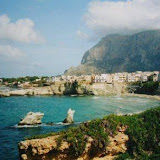
Having been ruled by Asians, Africans and Europeans, this wonderful island is a cosmopolitan place with a multicultural society. Imagine this: Sicily have been a Greek colony, a Roman province, an Arab emirate and a Norman kingdom. The Phoenicians, Carthaginians, Swabians, Angevins and Aragonese made Sicily their own, leaving behind an eclectic history that you can still touch today!
Knowing this is easy to understand why this land is so complex, and why it’s a land like no other.
WHAT TO DO THERE
Just because the great natural beauty of the land (Sicily is an island in the sun, with heavenly beaches, majestic mountains and Europe's greatest vulcan, Mount Etna) and the incredible complexity of it’s history, there is really very much to do there!
Basically, you can group your activities in Sicily into five main categories:
Swimming. The island’s rocky coastline makes it an ideal diving platforms; snorkellers and scuba divers will appreciate the variety of marine life in its waters.
There are also plenty of beaches to choose from, particularly at Taormina in the north-east, which is part of a huge nature reserve, and Mondello, near the town of Palermo, one of the island’s most popular sandy beaches.
Climbing and Trekking. The Romans thought the 3,323-metre Mount Etna - which last erupted in 2001 - was the forge of Vulcan, the god of fire. Local authorities monitor its activity closely, and visitors can take a day trip up to its lava dunes and moon-like surface. If you don’t fancy the hike, the 70-mile Circumetnea railway runs around the base from Catania to Giarre Riposto. A round trip takes around five hours.
Driving. One of the best ways to explore the island is driving all around it, to explore the many historical and archaeological places. The Old Palermo (In just a few hours on foot you can explore some of Sicily’s most famous monuments and charming squares, such as the Piazza Pretoria), the Valley of Temples in Agrigento (The largest collection of classical Greek ruins in the world, with many well preserved temples, monuments and other buildings which create a truly surreal atmosphere), the Greek Amphitheater in Taormina (The view of Mount Etna and the sea beyond is absolutely superb at Taormina's 10,000-seat ancient Greek amphitheater, which was erected in the third century BC and expanded by the Romans),
Siracusa (with it's dense archeological zone, with theatres ancient churches, greek temples, norman battlements, baroque façade and much more), Monreale Duomo (A jewel of Norman architecture, well known for its magnificent series of mosaics adorning the whole interior), and many many other attractive places around this beautiful land.
Eating. Sicilian cuisine is one of the oldest in existence, and Sicilians even have a reasonable claim to the invention of pasta. Their cuisine represents Sicily's unique cultural mix, imaginatively combining fish, fruits, vegetables, and nuts with Arab and North African ingredients such as cus cus (couscous). Stop for a coffee anywhere in Sicily, even along the coastal road, and you'll be overwhelmed by an embarrassment of little riches, like fried sweet or savory dough pockets stuffed with ricotta. Every town has its own trademark snack, but they all have arancini, literally "little oranges," which are actually deep-fried risotto balls, one of Sicily's trademark snack foods. Driving around the most famous localities you can taste many specific and local cuisines. Also snacks are in rare form in Sicily. Catania is famous for sweets: pasta di mandorla, a soft cookie made from almonds and honey, is a delicious showcase for the famous Sicilian bitter almond. Going to Siracusa don't miss the spectacularly chaotic and wonderful fish market in the center of the city: fresh pesce spada (swordfish) and ricci (raw sea urchin) are a must!
Marsala is a sleepy town with an ancient Punic warship in its archeological museum and an amazing wine tradition that spans hundreds of years. You may encounter marsala wine more often in a dish of sauteed chicken or veal than you do as a after-dinner drink, but here, this fortified wine is taken very seriously.
Palermo is the place where you can have the chance to sample the island's most traditional home-cooked specialties. Pasta con le sarde (an emblematic dish that goes back to the Saracen conquerors, with fresh sardines, olive oil, raisins, pine nuts, and wild fennel) is different at every restaurant. Firm white fish such as orata (sea bream), simply grilled and served with lemon and olive oil, are reliable staples as secondi piatti almost anywhere in town. And nothing is more famous in Palermo, or in Sicily as a whole, than spaghetti alla Norma (with a sauce of tomato, fried eggplant, ricotta, and basil). Roberto Gardenti





